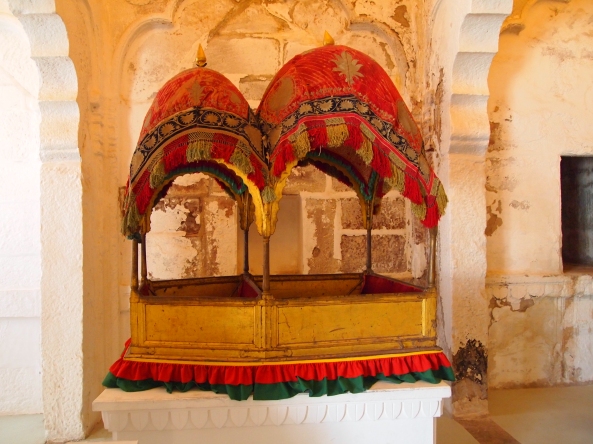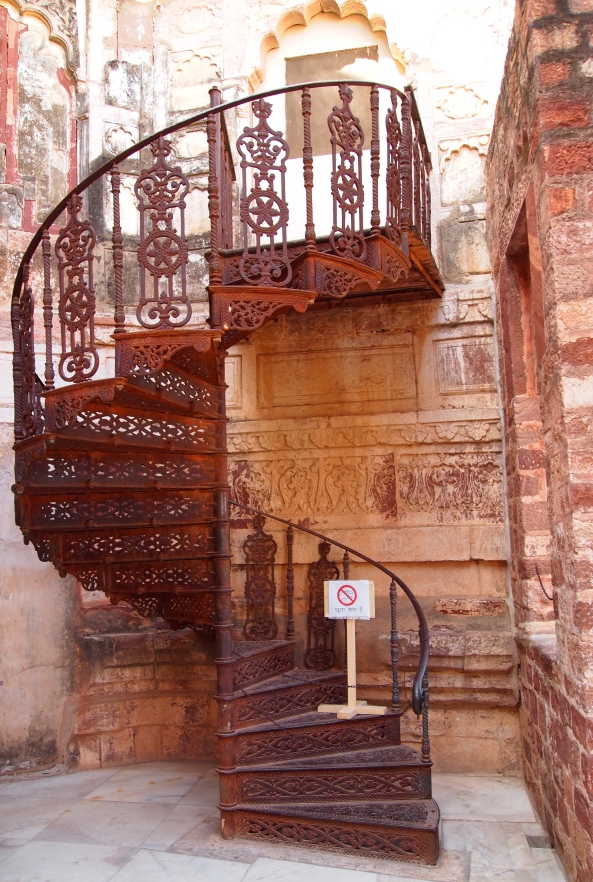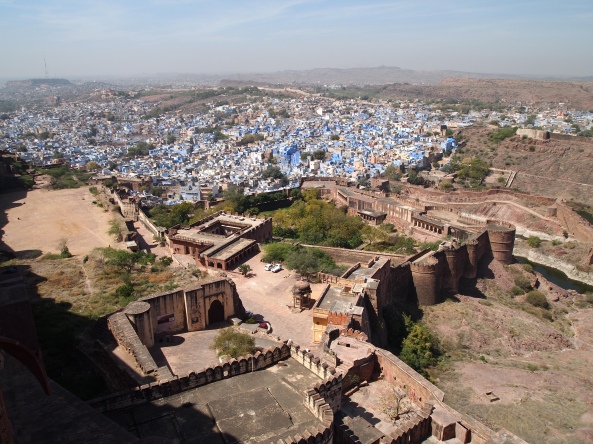Wednesday, March 16: We have a lot of time to kill today as we have to wait until 4:30 to take a train to Jodhpur. We are drained from all of our travels and don’t feel like going back to Jaisalmer Fort. We decide to go to a place we haven’t seen, Gadi Sagar, in the early morning before it gets too hot.

Me under the gate to Gadi Sagar
Gadi Sagar is simply a tank, south of the Jaisalmer city walls, which was once the water supply for the city. Small temples and shrines surround it, as well as a smattering of small shops. Over the road down to the tank is a gateway, Tilon-ki-Pol, which was built by a famous prostitute. The story is that the prostitute offered to pay for its construction, but the maharaja denied permission because he felt that it would be beneath his dignity to walk through it when visiting the tank. The prostitute built it anyway in the maharaja’s absence. She put a Krishna temple on top so the king wouldn’t tear it down.

the prostitute’s gate
Despite our early arrival, it’s steamy out, and we wander around sluggishly and half-heartedly. There is a possibility of a boat ride in the water tank, but when we see the condition of the boats and the pond itself, we decide just to wander around, keeping to the shade as much as possible. A group of Indian kids are standing on some steps, a kind of ghat, leading down to the water, and tossing bread into the murky depths. When we walk up close, we see a black mass of catfish hurling themselves up toward the surface. In their bulging and heaving madness, they look like frightening deep-sea creatures who are surfacing to devour us. Frankly, I’m disturbed by the sight of them, boiling cauldron of slimy snakes that they are.
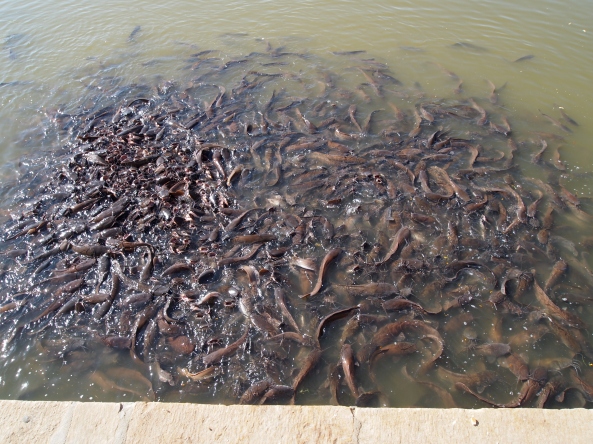
the boiling cauldron of catfish at Gadi Sagar
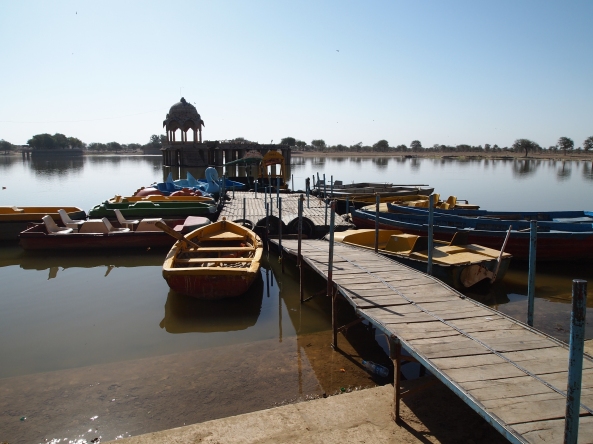
the boats at Gadi Sagar
We wander around a little more, dipping into the coolness of a Hindu temple decked out with strands of rainbow-colored tinsel and guarded by a large ceramic cat. A silent barefoot monk in a saffron robe watches us as we pad through in our bare feet.

a monk in the temple at Gadi Sagar

the entrance to the temple at Gadi Sagar

looking out from the Temple to the lake

a pavilion outside the Temple
Back on the road again, we encounter a camel decked out in colorful blankets and fabric braids pulling a painted carriage. We look briefly into the small shops. Bored, we decide we’ll return to the hotel and relax for the rest of the afternoon. Back at Himmatgarh Palace, I eat Vegetable Pulao and Jayne eats Kashmiri Pulao, both accompanied by stuffed naan with cheese and two lime sodas. Then we pack up most of our stuff and lounge around in the cool room reading and trying unsuccessfully to nap.

a decked out camel and carriage
Actually, I’m not able to relax knowing that the dreaded train lies before us this evening. I read pages and pages of White Tiger by Aravind Adiga this afternoon, which makes me more uptight. His bleak and dark descriptions of India only exacerbate the feeling of unease I have regarding the remainder of our trip and this train. I hated so much the 12-hour trip from Jaipur; this will be another 6 hours of torture to Jodhpur. Plus, because this is not an overnight train, I don’t know what kind of compartment or seating to expect. I frankly am experiencing a great deal of anxiety on this day, between reading this book and fearing our journey tonight.

back at the hotel before the dreaded train ride to jodhpur

the pool at our hotel ~ Himmatgarh Palace
Finally, after what seems like an interminable afternoon (why can’t I relax??), our driver takes us to the train station. We sit on a bench on the platform, awaiting our train, beneath multitudes of pigeons in the rafters. Suddenly, one of the pigeons shits on my hand. A lady from Calgary sharing the bench with us says, in unison with Jayne, “That’s good luck!” I find a tissue and wipe off the wet droppings as the pigeons flap and wheel overhead.
Indians are sleeping on the platform, whole filthy families camped out on every inch of concrete. The grimy train pulls up, and people are crammed into the luggage cars or bursting through open, iron-barred windows in second class. We haul our luggage onto our A-1 car (first class) and find the same type of compartment, with the 4 bunks, that we had on our overnight trip to Jaisalmer. I guess that’s a relief since it means we can recline and be somewhat comfortable.
As the train moves, I settle in to finish my book. An Indian guy comes into our compartment and plops down beside me on my mattress. “Let me tell you about my nation,” he says. We ignore him but he keeps on talking. I say, “No one invited you to sit on my seat! Please move!” He says, “You could be my mother.” This irritates me so much that, when the train conductor walks by, I insist that he make the guy move. He leaves, obviously angry that I refused to listen to his diatribe.
On the rest of this train ride, I finish reading White Tiger, which I happily abandon on the train when I disembark. The book is a brutal depiction of India’s class struggles. The main character Balram Halwai, a racist, homicidal chauffeur, is from the Darkness, born where India’s downtrodden and unlucky are destined to rot. Balram escapes his village and moves to Delhi after being hired as a driver for a rich landlord. Author Adiga’s crude and brutally honest prose animates the battle between India’s wealthy and poor as Balram suffers degrading treatment at the hands of his masters. Later, Balram manages to become a wealthy entrepreneur only after he murders his employer and steals a huge amount of money from him. This is seemingly the only way to get ahead under India’s rigid hierarchical society. The book has been such a good companion on this trip only because it only served to underline the poverty and degradation I could see all around me. I want so badly to see some good in India, and this is why I am happy to finish with the book and leave it behind.
When we arrive in Jodhpur at around 10:30 pm, it’s a nightmare. First, there is no one from our hotel to pick us up. In most other countries, this would be no problem. We would just take a taxi to the hotel. But in India, we have been warned that we should never take a rickshaw to a new hotel upon our arrival in town. A rickshaw driver, it is said, will always have a story that the hotel where you are headed is out of business or full. And then he will take you to a hotel where he gets a kickback. He will leave you stranded at the new hotel, which often charges exorbitant prices.
This would be a problem for us. Our whole time in India is arranged. We have prepaid for the entire trip and we have in fact a reservation tonight at the Hotel Pal Haveli. This hotel, set around a courtyard and built by the thakur (nobleman) of Pal in 1847, is considered the most attractive original haveli in the old city. Even though we are only due to stay this one night in Jodhpur, this is one of the nicer hotels, a “heritage” property, Umer booked for us on our itinerary. We definitely don’t want some rickshaw driver to take us somewhere else, where 1) we have to pay extra and 2) we don’t get to stay in a top-rate hotel.
We stand outside in front of the station in the dark, where people are sleeping all over the concrete, like fallen dominoes. One lady has her head on another lady’s stomach; a man has his feet on someone else’s chest. Some have their heads propped on their baggage. A fat orange-haired lady in a sari sleeps directly on the concrete while huge rats sniff around her face. Fluorescent lights cast an eerie glow over the whole scene. All these people are sleeping directly on the concrete, no sheets or blankets to shield them from the hordes of rats scurrying about. Auto-rickshaws are lined up on the street, bathed in the sickly light. Young men keep coming up and asking us where we are going. They say, “Pal Haveli? Pal Haveli?” We say, who are you here for? We don’t tell our names but insist that they tell us who they are here to pick up. Finally, after many phone calls, they tell us a name that is not Jayne’s. We say, no, you are not here for us.

on the train to jodhpur’s nightmare train station
We don’t have phones with us here. I have only my U.S. BlackBerry which has our travel agent Umer’s number. However, my BlackBerry is on a different network and has only worked a couple of times in India. I try to phone Umer, but get no answer at all.
Finally, I watch the luggage while Jayne asks one of the attendants at the station to call the hotel for us. We don’t know the number of the hotel and neither does the attendant. After a long time, and many phone calls, the attendant tells us the Pal Haveli is not waiting for any guests tonight. Apparently, we find out later, the attendant has called his cousin to find out this information.

our room at the Pal Haveli ~ FINALLY!!
We have the attendant call Umer, who is conveniently not available. This seems to happen whenever we run across a problem in our travels and tonight, we find this infuriating. We feel lost and abandoned. Umer has really let us down.
Finally, after what seems like a highly uncomfortable eternity, we are able to get someone to speak to the Pal Haveli, which sends a car for us. They are able to tell us Jayne’s name, so we finally know we have the right driver.
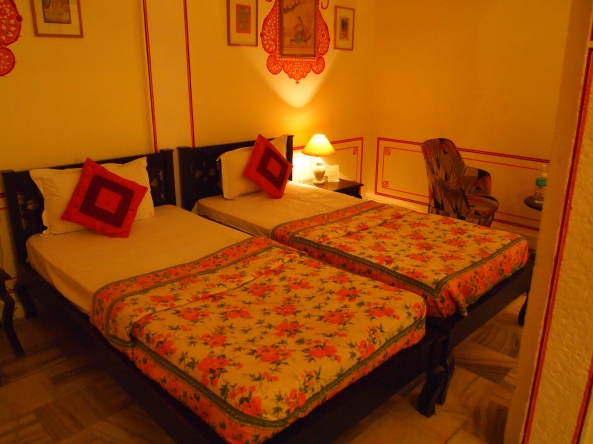
I love this room ~ too bad we have such a short enjoyment time slot…
Close to midnight, we finally get to the hotel, almost 1 ½ hours after our arrival in Jodhpur. The hotel staff tells us they have our reservation, but our travel agent didn’t specify that we needed a train station pickup. No arrangements had been made and they are unabashedly unapologetic. We had really looked forward to dinner at the hotel’s rooftop restaurant, Indique, which is the top restaurant pick in Lonely Planet for Jodhpur: it “is the perfect place for a romantic dinner…the views to the fort, clock tower, and Umaid Bhawan are superb. The food is traditional tandoori and North Indian curries and you won’t be disappointed by the old favorites – butter chicken and rogan josh.”
Our room is actually lovely, with its heritage trimmings, and the kitchen is able to provide room service. They bring us the most delicious chicken tikka and cheese naan, a soothing antidote to our nightmare of a night.
38.893151
-77.357877














